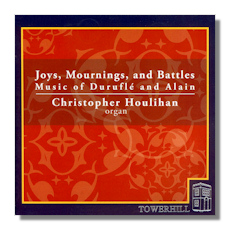
The Internet's Premier Classical Music Source
Related Links
-
Alain Reviews
Duruflé Reviews - Latest Reviews
- More Reviews
-
By Composer
-
Collections
DVD & Blu-ray
Books
Concert Reviews
Articles/Interviews
Software
Audio
Search Amazon
Recommended Links
Site News
 CD Review
CD Review
Joys, Mournings, and Battles

Organ Music
- Maurice Duruflé:
- Suite for Organ
- Prelude & Fugue on A.L.A.I.N.
- Jehan-Ariste Alain: Three Dances, AWV 119/Op. 81
Christopher Houlihan, organ
Rice Memorial Organ, All Saints Church, Worcester, Mass.
Towerhill Recordings TH-72025 63:45
Perhaps best known for his Requiem, often paired with Faure's Requiem on recordings, Duruflé (1902-1986) studied organ with Vierne and composition with Dukas. The opening of this suite sounds ominous, as Houlihan agrees in his notes. Eventually there are some rippling tones and the last third of its nearly ten minute duration is gentle and pleasant. The Sicilienne, a pastoral form sometimes thought of as a slow gigue, though actually not usually considered a dance, is lovely. It has quiet, lilting melody, with simultaneous high and low notes. Duruflé later re-did this piece for a small ensemble consisting of a wind quintet plus string quartet, but Houlihan notes that it is lacking the voix humaine of the organ version. Duruflé was disappointed with his toccata, finding the first theme inadequate, and his widow later refused to play the final movement. I find it exciting, however, and prefer it to the opening of the Prelude. It shows more of the organ's range than the rest of the suite.
Alain (1911-1940) wrote his Three Dances during the last two years of his life, which was terminated at age 29 in a battle near Saumur France; he was posthumously awarded the Croix de guerre. So he knew about battles and mourning. The pieces don't sound all that dancelike to be, though Houlihan says Alain was influenced by Jazz, Moroccan and Indian music. Alain is known also for his organ work "Litanies," but Houlihan says this piece is probably his "magnum opus" for organ, though Alain had originally intended it to be for orchestra, but lived only to complete the organ version. "Joys" has some exciting organ timbres. "Mournings," subtitled "a funeral dance to honor a heroic memory," is very moving, and it certainly can be music to grieve by. It may be particularly hard to hear it as a dance, but then one may consider that Vaughan Williams' rather grim "Job" is subtitled "A Masque for Dancing." Basically a sarabande, It begins as a dirge and "has frequent changes in color and character." Mostly "Mournings" is quiet but there is an angry outburst in the middle before it becomes quiet again. Anger is also a stage of grieving. "Battles" is relatively brief (a third of the length of the preceding movement). Beginning deep in the bass register, it presents heroic sounds. The final section is required to be played "brutally."
Duruflé's Prelude and Fugue on the name of A.L.A.I.N. (musically ADAAF) was written during the war, two years after Alain's death, in occupied Paris. It includes a theme from Alain's "Litanies." At the end of what Houlihan characterizes as the "atmospheric and perpetually-in-motion" Prelude, that theme is heard "in a calm and meditative way." The fugue begins quietly, is succeeded by a lively second subject, and ends with a big crescendo.
The organ used in these performances would appear to be one of the great instruments, with over seven thousand pipes: the Rice Memorial organ, Aeolian Skinner, opus 909, 1933, as recently refurbished, in All Saints Church, Worcester, Massachusetts.
A year ago I reviewed Houlihan's previous recording of works by Vierne and Widor (Tower TH72018), made when he was still an undergraduate but already the recipient of a number of distinctions and quite a fan following. At the time of the present recording he was a graduate student at Juilliard. Clearly he is destined for a distinguished career.
Copyright © 2010, R. James Tobin


















